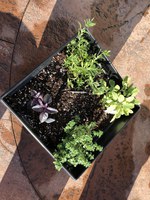Dakota Gardener: Reasons to Plant an Herb Garden
(Click an image below to view a high-resolution image that can be downloaded)
By Esther McGinnis, Horticulturist
NDSU Extension
Each year, I plant a container herb garden on my deck for convenient access to fresh herbs such as basil, oregano, parsley, cilantro and rosemary.
Nothing says summer like homegrown basil and it is heavenly in caprese salad, which consists of alternating layers of vine-ripened tomatoes, basil leaves and fresh mozzarella. This quintessential Italian salad then is topped with a drizzle of good-quality olive oil and balsamic vinegar.
Cooks also commonly plant basil to make fresh pesto. However, consider growing other herbs to process. My favorite alternative pesto is made from lemon thyme. When you bruise the lemon thyme leaves, they give off a wonderful lemony aroma.
An herb garden is more than just a kitchen convenience. It is a ready-made sensory garden for children.
When my daughter was a preschooler, the two of us planted an herb garden for her to safely explore the world of plants. She would smell the delicate fragrance of the lavender plant and feel the texture of the sage leaves.
For fun, I planted different mints such as spearmint, pineapple mint and even mint that tasted like chocolate. Every day after preschool, she would hop out of the car and taste test the mints.
For visual appeal, I planted pansies and nasturtiums to provide color. All the plants in this garden were edible and safe for a curious child.
Plant an herb garden to help the environment. Many herbs will bolt or flower in response to longer day lengths in summer. While the taste qualities of herbs will decline after they flower, this is not the time to discard the plants. Pollinators including bees and painted lady butterflies are nourished by the flowers.
Walking in the herb garden and seeing a cloud of painted lady butterflies take flight is fun. A short list of pollinator-approved flowering herbs includes chives, mint, basil, lavender, lemon balm and thyme.
Herbs should be grown in full sun (at least six hours of light daily) and in well-drained soils. Fertilize sparingly to avoid diluting the oils that give herbs their flavor.
Container plants may need to be watered more frequently during the heat of summer. Harvest sprigs in the morning when the plant is fully hydrated. The herbs are at their most flavorful just before the plants flower.
If growing mint, planting in a container is better than growing it in the garden. Mint is a perennial in our climate and can spread very vigorously by rhizomes in the garden.
Everyone wants to know if lavender is hardy enough to overwinter in the northern Great Plains. ‘Munstead’ and ‘Hidcote’ are two of the hardier cultivars. However, neither one will survive winter reliably in the north country.
Both cultivars are listed as hardy to U.S. Department of Agriculture Zone 5 (think Chicago). Plants may be able to survive a winter or two if grown in a protected microclimate with sandy soils and plenty of snow cover.
Finally, think of your herb garden as a source to spice up your drinks. Lemon balm leaves are refreshing in ice tea after a long day of gardening.
For information on growing and preparing herbs, visit https://tinyurl.com/wxyf2bv2.
For more information about gardening, contact your local NDSU Extension agent. Find the Extension office for your county at https://www.ag.ndsu.edu/extension/directory/counties.
NDSU Agriculture Communication - May 25, 2021
Source: Esther McGinnis, 701-231-7971, esther.mcginnis@ndsu.edu
Editor: Ellen Crawford, 701-231-5391, ellen.crawford@ndsu.edu




